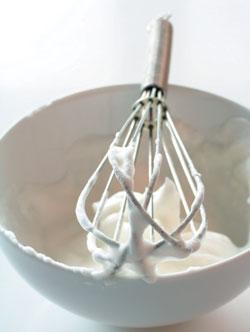The rule when whipping egg whites is to make sure that there is no fat in your mixture as this inhibits their ability to whip properly. Clean your hands thoroughly and make sure that your bowl and whisk are absolutely clean. Also ensure that there is no yolk in your white mixture. I would suggest breaking your eggs individually into a smaller bowl before adding them to the mixing bowl. It’s easier to separate eggs if they are cold as the yolks don’t break so easily. However, egg whites whip far better at room temperature. Whipping egg whites to different stages affects the texture of a dessert. Meringues and cookies require a firmer mixture while most batters and cakes require a softer, looser consistency.
KNOWING YOUR STAGES
• Soft peak: Whip egg whites until they form peaks that collapse when you remove the whisk.
• Stiff peak: Continue to whip the whites until they form sharp peaks that stand on their own.
• Overbeaten: This occurs when the egg whites have been beaten past stiff peak stage and begin to look curdled. The mixture can’t be used.
COOK’S TIPS
• Adding cream of tartar, salt or an acid such as vinegar or lemon juice will make the egg whites more stable and they will whip more quickly.
• Stainless steel and copper bowls yield the best results; plastic can retain traces of fat even after washing.

